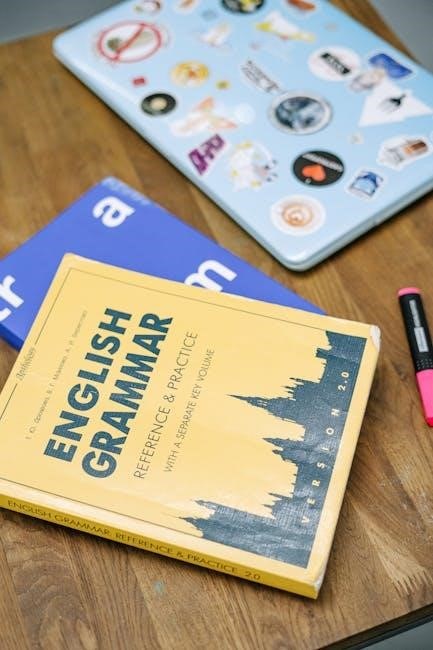The WorkKeys Reading Practice Test PDF is a valuable resource designed to help individuals assess and improve their workplace reading skills. Developed by ACT, Inc., it provides authentic practice questions and materials to prepare for the actual WorkKeys Reading for Information test. This PDF is essential for anyone seeking to enhance their job readiness and performance in workplace-related reading tasks. It offers a clear and structured format, mirroring the real test, and is accessible for offline study. By using this practice test, individuals can familiarize themselves with the test structure, identify areas for improvement, and build confidence in their reading abilities;
What is the WorkKeys Reading Practice Test?
The WorkKeys Reading Practice Test is a diagnostic tool designed to evaluate and enhance workplace reading skills. Created by ACT, Inc., it assesses an individual’s ability to comprehend and interpret workplace-related texts. The test includes passages and questions that mirror real-work scenarios, covering four skill levels (1-4). It features multiple-choice questions with five answer options, requiring test-takers to identify main ideas, supporting details, and make logical inferences. The practice test is available in PDF format, containing 33 questions to be completed within 45 minutes. It provides examples of reading materials and questions from the actual WorkKeys Reading for Information test, helping users familiarize themselves with the format and identify strengths and weaknesses. This resource is ideal for individuals preparing for the assessment and seeking to improve their job readiness and performance in workplace reading tasks.
Purpose of the WorkKeys Reading Practice Test
The primary purpose of the WorkKeys Reading Practice Test is to prepare individuals for the actual WorkKeys Reading for Information assessment. It provides a realistic preview of the test format, question types, and difficulty levels, allowing users to familiarize themselves with what to expect. The practice test helps identify strengths and weaknesses, enabling targeted study and improvement. Additionally, it serves as a tool for employers and educators to assess workplace readiness and career readiness among students and job seekers. By offering a simulation of the actual test experience, the practice test builds confidence and reduces anxiety, ensuring individuals are well-prepared to demonstrate their reading skills effectively in real-world work environments. This resource is essential for anyone aiming to enhance their job performance and career opportunities through improved reading abilities.
Benefits of Using the WorkKeys Reading Practice Test PDF
The WorkKeys Reading Practice Test PDF offers numerous benefits for individuals preparing for the assessment. It provides access to over 300 practice questions, allowing users to familiarize themselves with the test format and content. The PDF includes multiple-choice items with five answer options, mirroring the actual test, and covers questions from skill levels 1 to 4. This helps identify strengths and weaknesses, enabling targeted study. Additionally, the printable format allows for offline preparation, offering flexibility and convenience. The practice test also helps reduce test anxiety by simulating real exam conditions. By using this resource, individuals can improve their reading skills, enhance workplace readiness, and gain confidence in their ability to perform well on the actual WorkKeys Reading for Information test.

Historical Background of WorkKeys Assessments
Developed in the 1990s by ACT, Inc., WorkKeys assessments were created to measure workplace skills, aligning education with employer needs and featuring a leveling system for proficiency.
Development of WorkKeys by ACT, Inc.
ACT, Inc., a renowned educational assessment organization, developed the WorkKeys system in the early 1990s to address the growing need for workplace skills assessments. Recognizing the gap between education and employer expectations, ACT created WorkKeys to measure essential skills required for job success. The system was designed to evaluate skills like reading, mathematics, and problem-solving, aligning with real-world job demands. WorkKeys assessments were built on a foundation of extensive research and employer feedback, ensuring their relevance and effectiveness. The tests were structured to provide a clear, objective measure of workplace readiness, making them a valuable tool for both employers and educators. This development marked a significant step in bridging education and employment needs.
Evolution of WorkKeys Tests Over the Years
Since its introduction, WorkKeys assessments have undergone significant updates to reflect changing workplace demands and advancements in testing technology. Initially launched in the early 1990s by ACT, Inc., the tests were designed to measure foundational job skills. Over time, WorkKeys evolved to include digital delivery options, enhancing accessibility and convenience. The tests also incorporated adaptive testing technology, allowing for more precise skill level assessments. Additionally, the content was updated to address emerging workplace skills, such as the use of technology and critical thinking. These advancements ensure WorkKeys remains relevant, providing accurate and reliable measures of workplace readiness. Continuous improvements have solidified its role as a trusted tool for skills assessment.
Importance of WorkKeys in Modern Workplace Skills Assessment
WorkKeys plays a vital role in modern workplace skills assessment by providing a standardized measure of essential job skills, such as reading, math, and problem-solving. Employers rely on WorkKeys to identify candidates with the necessary skills for specific roles, ensuring better job performance and reduced training costs. It bridges the gap between education and workplace requirements, helping individuals demonstrate their readiness for employment. The WorkKeys Reading Practice Test PDF is particularly valuable, as it prepares individuals for the assessments while enhancing their workplace reading skills. By aligning education with workplace demands, WorkKeys fosters a more skilled and competitive workforce, driving innovation and productivity across industries.

Structure of the WorkKeys Reading for Information Test
The WorkKeys Reading for Information Test is a 45-minute, 33-question assessment. It evaluates the ability to locate and use workplace document information effectively.
Overview of the Reading for Information Test Format
The Reading for Information Test is designed to assess the ability to locate, comprehend, and use information from workplace documents. The test includes various types of documents, such as memos, diagrams, and policy statements. Each question requires the test-taker to read and analyze the provided information to select the correct answer. The format is straightforward, with clear instructions and a consistent layout for all questions.
The test emphasizes practical workplace scenarios, ensuring the content is relevant to real-world job tasks. By simulating actual work-related reading challenges, the test helps employers evaluate candidates’ ability to interpret and apply written information effectively in professional settings. This structure makes it an essential tool for assessing foundational workplace literacy skills.
Question Types and Difficulty Levels (1-4)
The WorkKeys Reading for Information Test features multiple-choice questions categorized into four difficulty levels, ranging from Level 1 (basic) to Level 4 (advanced). Level 1 focuses on locating straightforward information, while Level 2 requires identifying details and making simple inferences. Level 3 involves analyzing complex documents and drawing logical conclusions. Level 4 demands the highest skill, including understanding nuanced information and evaluating evidence. Questions are designed to mirror real workplace scenarios, ensuring practical application. The test includes various question types, such as identifying main ideas, supporting details, and vocabulary in context. This structure helps employers assess a candidate’s ability to interpret and use written information effectively in professional settings.
Time Management: 33 Questions in 45 Minutes
The WorkKeys Reading for Information Test consists of 33 questions that must be completed within 45 minutes. This time frame requires careful planning to ensure all questions are addressed. On average, test-takers have about 1 minute and 22 seconds per question. Effective time management is crucial, as rushing may lead to errors, while spending too much time on one question can leave insufficient time for others. Strategies include skimming passages quickly for key details, prioritizing questions that seem easier, and using the process of elimination for unclear answers. Practicing under timed conditions during preparation helps build speed and accuracy, ensuring optimal performance on the actual test.

WorkKeys Reading Practice Test PDF Content
The WorkKeys Reading Practice Test PDF includes authentic passages, multiple-choice questions, and answer keys, mirroring the actual assessment to help candidates prepare effectively for the test.
Passages and Questions in the Practice Test
The WorkKeys Reading Practice Test PDF includes a variety of passages and questions designed to reflect real workplace scenarios. Passages cover topics like workplace policies, technical instructions, and graphs or charts, ensuring relevance to job-related reading tasks. Questions are crafted to assess comprehension, detail identification, and the ability to make logical inferences. Each passage is paired with multiple-choice questions, requiring test-takers to demonstrate their ability to extract and interpret information accurately. The practice test mimics the format of the actual WorkKeys assessment, allowing individuals to familiarize themselves with the types of questions they will encounter. This alignment helps build confidence and improves readiness for the actual test experience.
Multiple-Choice Items with Five Answer Options
The WorkKeys Reading Practice Test PDF features multiple-choice questions with five answer options, mirroring the format of the actual assessment. Each question is designed to evaluate specific reading comprehension skills, such as identifying main ideas, understanding details, and making logical inferences. The five-answer format ensures a balance between reducing guessing and challenging test-takers to carefully analyze passages. Answer options are crafted to include plausible distractors, requiring close reading and critical thinking. This structure helps individuals prepare for the actual test by familiarizing them with the question style and response format. It also allows users to refine their ability to identify correct answers efficiently and accurately.
How the Practice Test Mirrors the Actual Assessment
The WorkKeys Reading Practice Test PDF is designed to closely replicate the actual WorkKeys Reading for Information test, ensuring a realistic preparation experience. It features similar passage lengths, question formats, and content difficulty to the official assessment. The practice test includes 33 questions to be completed in 45 minutes, matching the time constraints of the real test. Additionally, it uses the same scoring system, providing a clear measure of performance across the four skill levels. By mirroring the actual test structure, the practice PDF helps users build familiarity with the format, identify areas for improvement, and develop effective test-taking strategies. This alignment ensures a seamless transition to the actual assessment.

Features of the WorkKeys Reading Practice Test PDF
The WorkKeys Reading Practice Test PDF offers free and paid versions, a printable format, and over 300 practice questions to aid comprehensive preparation and effective skill improvement.
Availability of Free and Paid Practice Tests
The WorkKeys Reading Practice Test PDF is available in both free and paid versions, catering to different preparation needs. The free version provides a basic overview of the test format and sample questions, ideal for initial familiarization. Paid versions offer more comprehensive resources, including additional practice questions, detailed answer explanations, and progress tracking tools. Both options are designed to help candidates prepare effectively, with the paid version offering enhanced features for in-depth study. This dual availability ensures that test-takers can choose the option that best fits their budget and preparation requirements, providing flexibility and accessibility to high-quality study materials.
Printable Format for Offline Preparation
The WorkKeys Reading Practice Test PDF is designed to be easily printable, allowing candidates to prepare offline without needing internet access. This feature is particularly beneficial for those who prefer traditional study methods or have limited connectivity. The printable format includes all necessary materials, such as sample passages, questions, and answer keys, ensuring a seamless study experience. By printing the PDF, test-takers can highlight important sections, take notes, and review content multiple times, enhancing their understanding and retention. This flexibility makes the WorkKeys Reading Practice Test PDF a versatile tool for effective preparation, catering to individual learning preferences and environments. Offline access also reduces distractions, enabling focused study sessions.
Access to 300+ Practice Questions
The WorkKeys Reading Practice Test PDF provides access to over 300 practice questions, offering a comprehensive resource for test preparation. These questions are carefully designed to mirror the actual assessment, covering a wide range of reading skills and workplace scenarios. With such an extensive bank of questions, test-takers can thoroughly familiarize themselves with the test format and content. The variety ensures that candidates can practice different question types, such as identifying main ideas, understanding supporting details, and making inferences. This abundance of practice material helps identify strengths and weaknesses, allowing for targeted study and improved performance. The questions are organized to reflect real-world workplace reading tasks, making preparation both relevant and effective. This extensive practice opportunity is a key feature of the WorkKeys Reading Practice Test PDF, enabling candidates to build confidence and readiness for the actual exam.

Using the WorkKeys Reading Practice Test Effectively
Effectively using the WorkKeys Reading Practice Test involves understanding its structure, identifying personal strengths and weaknesses, and focusing study efforts on areas needing improvement.
Familiarizing Yourself with the Test Format
Familiarizing yourself with the WorkKeys Reading Practice Test format is crucial for success. The test includes passages and questions that mimic real workplace scenarios, helping you understand the structure and timing. By reviewing the practice test, you can identify the types of passages, such as memos, diagrams, and policy documents, and the question formats, like multiple-choice items. This preparation reduces test-day anxiety and allows you to focus on the content rather than the format. Understanding the layout ensures you can navigate the test efficiently, managing your time wisely during the actual assessment. This step is essential for building confidence and improving performance.
Identifying Strengths and Weaknesses
Using the WorkKeys Reading Practice Test PDF helps you identify your strengths and weaknesses in workplace reading skills. By analyzing your scores, you can pinpoint areas where you excel, such as understanding complex instructions or identifying main ideas. Conversely, you may discover challenges with detailed comprehension or vocabulary. Reviewing incorrect answers allows you to address gaps in knowledge and improve accuracy. This self-assessment tool enables targeted study, ensuring you focus on areas needing improvement while reinforcing your strengths. Regular practice and score tracking help monitor progress, building confidence for the actual test and enhancing overall reading proficiency for workplace success.
Utilizing the Practice Test for Targeted Study
The WorkKeys Reading Practice Test PDF is a valuable tool for targeted study, allowing you to focus on specific areas needing improvement. Begin by taking the practice test to identify your strengths and weaknesses. The feedback will highlight skill gaps, such as difficulty with main ideas or vocabulary. Use this information to create a study plan, prioritizing weaker areas. Review explanations for correct answers to learn from mistakes and avoid repetitions. Consider additional resources like textbooks or online courses for deeper learning. Retake the practice test to track progress and adjust your plan. By continuously analyzing and addressing gaps, you enhance your reading skills efficiently, ensuring better performance on the actual WorkKeys assessment and in workplace scenarios.

Test-Taking Strategies for Success
Skimming and scanning techniques help identify main ideas quickly. Identifying main ideas and supporting details ensures accurate answers. Using context clues aids in understanding unfamiliar vocabulary efficiently.
Skimming and Scanning Techniques
Skimming and scanning are essential strategies for the WorkKeys Reading Practice Test. Skimming involves quickly reading headings, summaries, and key phrases to grasp the main idea of a passage. This technique saves time and helps focus on critical information. Scanning, on the other hand, involves searching for specific details, such as names, dates, or keywords, within the text. Both methods are vital for efficiently managing the 45-minute time frame and answering questions accurately. By mastering these techniques, test-takers can prioritize information, reduce reading time, and improve overall performance. Regular practice with the WorkKeys Reading Practice Test PDF helps refine these skills, ensuring better time management and accuracy during the actual assessment.
Identifying Main Ideas and Supporting Details
Identifying main ideas and supporting details is a critical skill for the WorkKeys Reading Practice Test. The main idea is the central point of a passage, while supporting details provide evidence or explanations to back it up. To locate the main idea, focus on the topic sentence, often found in the first or last sentence of a paragraph. Supporting details can be identified by looking for specific examples, statistics, or explanations that elaborate on the main idea. Practicing with the WorkKeys Reading Practice Test PDF helps you refine this skill, ensuring you can quickly pinpoint key information and improve your ability to answer questions accurately. This skill is essential for workplace reading tasks, where understanding the core message and its backing details is crucial for decision-making and problem-solving.
Using Context Clues for Vocabulary and Inferences
Using context clues is a vital strategy for the WorkKeys Reading Practice Test, enabling you to decode unfamiliar vocabulary and make logical inferences. Context clues are hints within the text that provide meaning for unknown words or imply ideas not directly stated. For vocabulary, look for synonyms, antonyms, or definitions embedded in the sentence. For inferences, consider the tone, comparisons, or cause-effect relationships. The WorkKeys Reading Practice Test PDF includes passages that require these skills, helping you improve your ability to interpret complex texts. Regular practice with the PDF enhances your capacity to extract meaning from context, a skill essential for workplace reading and decision-making. Mastering this technique ensures better comprehension and accuracy in answering test questions.

Understanding WorkKeys Reading Test Scoring
The WorkKeys Reading Test scores range from 1 to 4, reflecting workplace reading skills. Higher scores indicate stronger abilities. The practice test PDF helps prepare for the actual assessment.
How the Test is Scored
The WorkKeys Reading for Information test is scored on a scale of 1 to 4, with 4 being the highest level of proficiency. Each question is assigned a specific point value, and the total score is based on the number of correct answers. The scoring reflects the test-taker’s ability to identify main ideas, locate details, and make inferences. The practice test PDF mirrors this scoring system, allowing users to understand how their performance aligns with workplace reading standards. Scores are not penalized for incorrect or unanswered questions, emphasizing accuracy over guessing. This scoring method ensures a clear understanding of one’s strengths and areas for improvement. The WorkKeys Reading Practice Test PDF provides detailed feedback, helping candidates interpret their results effectively. This feature is essential for targeted study and skill enhancement. By simulating the actual test’s scoring process, the practice test prepares individuals for the real assessment, ensuring they are well-equipped to demonstrate their reading skills accurately. The scoring system is designed to reflect real-world workplace demands, making it a reliable tool for career readiness.
Interpreting Your Test Results
Interpreting your WorkKeys Reading Practice Test results is straightforward, providing clear insights into your performance. The test assigns scores ranging from 1 to 4, reflecting your ability to comprehend workplace-related texts. A score of 4 indicates advanced skills, while a score of 1 suggests needing improvement. The practice test PDF includes a score breakdown, highlighting strengths and areas for growth. By reviewing your results, you can identify specific reading skills to focus on, such as identifying main ideas or making inferences. This feedback is invaluable for targeted study and improvement. Tracking your progress over time helps refine your strategies and build confidence. Understanding your results enables you to address weaknesses effectively, ensuring readiness for the actual WorkKeys assessment and workplace reading demands.
Understanding the Skill Levels (1-4)
The WorkKeys Reading Practice Test PDF evaluates skills across four levels, ranging from basic to advanced reading abilities. Level 1 focuses on identifying simple facts and details in short, straightforward texts. Level 2 involves locating and comparing information in slightly more complex passages. Level 3 requires understanding main ideas, supporting details, and making logical inferences. Level 4, the highest, demands analyzing complex texts, synthesizing information, and applying critical thinking. These levels align with workplace reading demands, ensuring that test-takers can demonstrate their readiness for real-world scenarios. Understanding these skill levels helps individuals and employers identify proficiency and determine training needs effectively.

Resources for WorkKeys Reading Preparation
Official ACT materials, third-party guides, and online forums provide comprehensive preparation resources, ensuring access to practice tests, study tips, and community support for exam success.
Official ACT WorkKeys Study Materials
Official ACT WorkKeys study materials are the most reliable resources for preparing for the Reading for Information test. These materials include the WorkKeys Reading Practice Test PDF, which mirrors the actual test format and content. ACT provides detailed study guides, sample questions, and explanations to help candidates understand the test structure and improve their skills. The official materials are designed to familiarize test-takers with the question types, difficulty levels, and time constraints. Additionally, ACT offers online tutorials and practice assessments that align with the latest WorkKeys updates. By using these resources, individuals can gain a deeper understanding of workplace reading skills and develop strategies to achieve higher scores.
Third-Party Practice Tests and Guides
Besides official materials, third-party practice tests and guides are widely available to help prepare for the WorkKeys Reading Practice Test PDF. These resources, offered by educational platforms and test prep companies, provide additional practice questions, detailed explanations, and study strategies. Many third-party guides focus on workplace reading scenarios, mirroring the content of the official test. They often include interactive tools and progress tracking features to enhance learning. While these materials are not created by ACT, they can complement official study resources and offer a fresh perspective. However, it’s essential to ensure that third-party materials align with the latest WorkKeys updates and maintain high quality standards.
Online Communities and Forums for Support
Online communities and forums provide valuable support for individuals preparing for the WorkKeys Reading Practice Test PDF. Platforms like Reddit, Facebook groups, and specialized educational forums offer spaces to connect with others who are also preparing for the test. These communities often share tips, strategies, and resources, including study guides and practice materials. Many users post their experiences, offering insights into challenging questions and effective study habits. Additionally, some forums host live Q&A sessions with experts or experienced test-takers. Engaging with these communities can help learners stay motivated and gain a deeper understanding of the test format. They also provide opportunities to discuss common challenges and solutions, fostering a sense of collaboration and shared growth.

Additional Tips for WorkKeys Reading Success
Regularly reviewing mistakes enhances accuracy, and strengthening workplace reading skills through practical exercises significantly improves overall test performance and job readiness over time effectively thereby.
Practicing Under Timed Conditions
Practicing under timed conditions is crucial for mastering the WorkKeys Reading Practice Test. Set a timer for 45 minutes and complete the test in one sitting to simulate real-test pressure. This helps build stamina and reduces anxiety. Focus on answering questions efficiently, prioritizing those you feel confident about first. Use the remaining time to address challenging items. Timed practice reveals areas where you may need to allocate more time, helping you refine your strategy. Regularly reviewing your progress under timed conditions strengthens your ability to manage time effectively, ensuring you can complete all questions within the allotted period. This approach enhances both speed and accuracy, key to achieving a high score.
Reviewing Mistakes to Improve Accuracy
Reviewing mistakes is a vital step in improving accuracy on the WorkKeys Reading Practice Test. After completing the test, carefully analyze each incorrect answer to understand where you went wrong. Identify patterns in your errors, such as misreading questions or misunderstanding passage content. Focus on learning from these mistakes by revisiting the relevant passages and questions. Use the answer explanations provided in the PDF to grasp the correct reasoning. This process helps strengthen weak areas and builds confidence. Regularly reviewing mistakes ensures that you avoid repeating them in future tests, leading to better performance and higher scores. Consistent review is key to achieving accuracy and mastery of the material.
Enhancing Workplace Reading Skills
Enhancing workplace reading skills is essential for success in many industries, and the WorkKeys Reading Practice Test PDF is a valuable tool for achieving this goal. By regularly practicing with the PDF, individuals can improve their ability to quickly and accurately interpret workplace documents, such as memos, instructions, and reports. The test focuses on scenarios that mimic real-life work situations, helping users develop the skills needed to comprehend complex texts under time constraints. Additionally, the practice test helps users refine their ability to identify key details, make logical inferences, and apply context clues to unfamiliar vocabulary. Over time, this practice leads to stronger workplace reading proficiency and better job performance.
